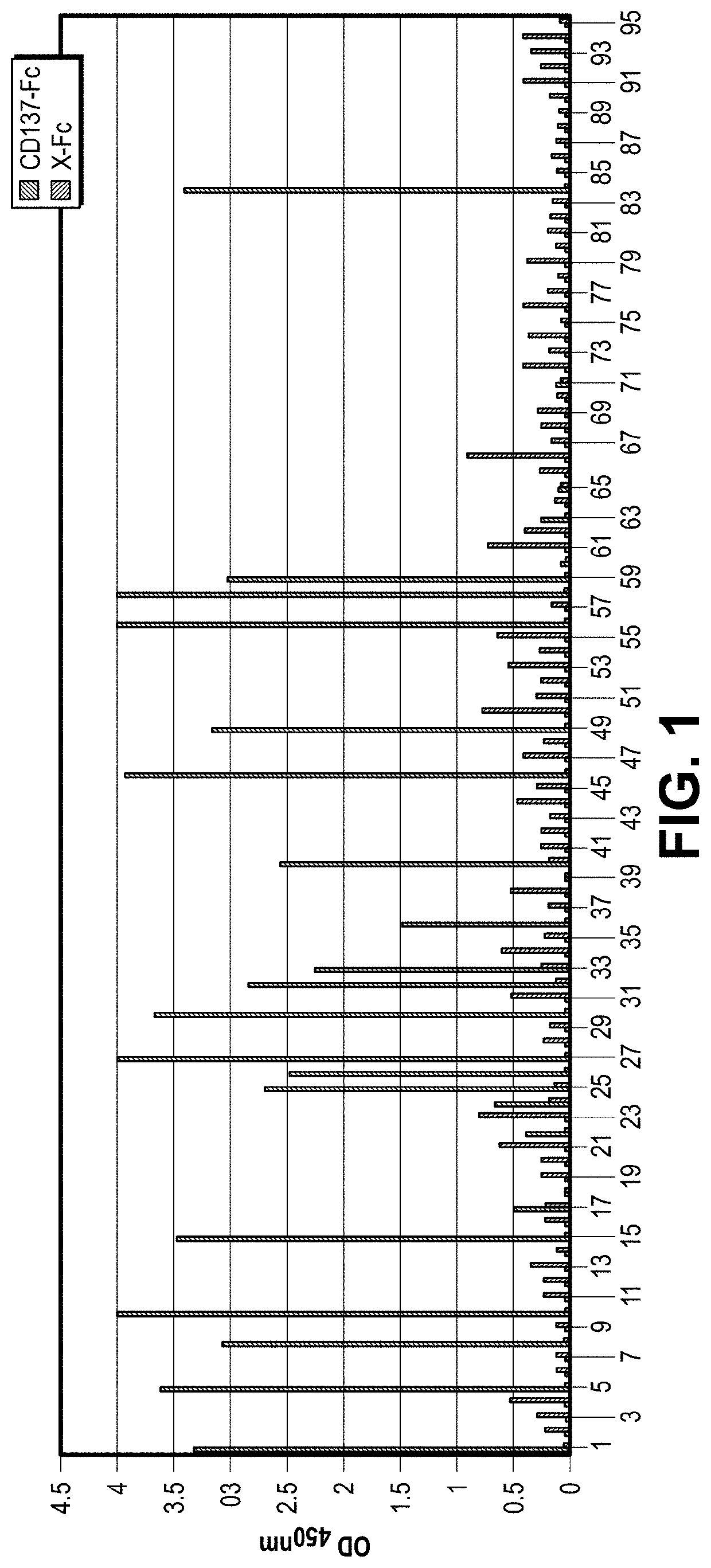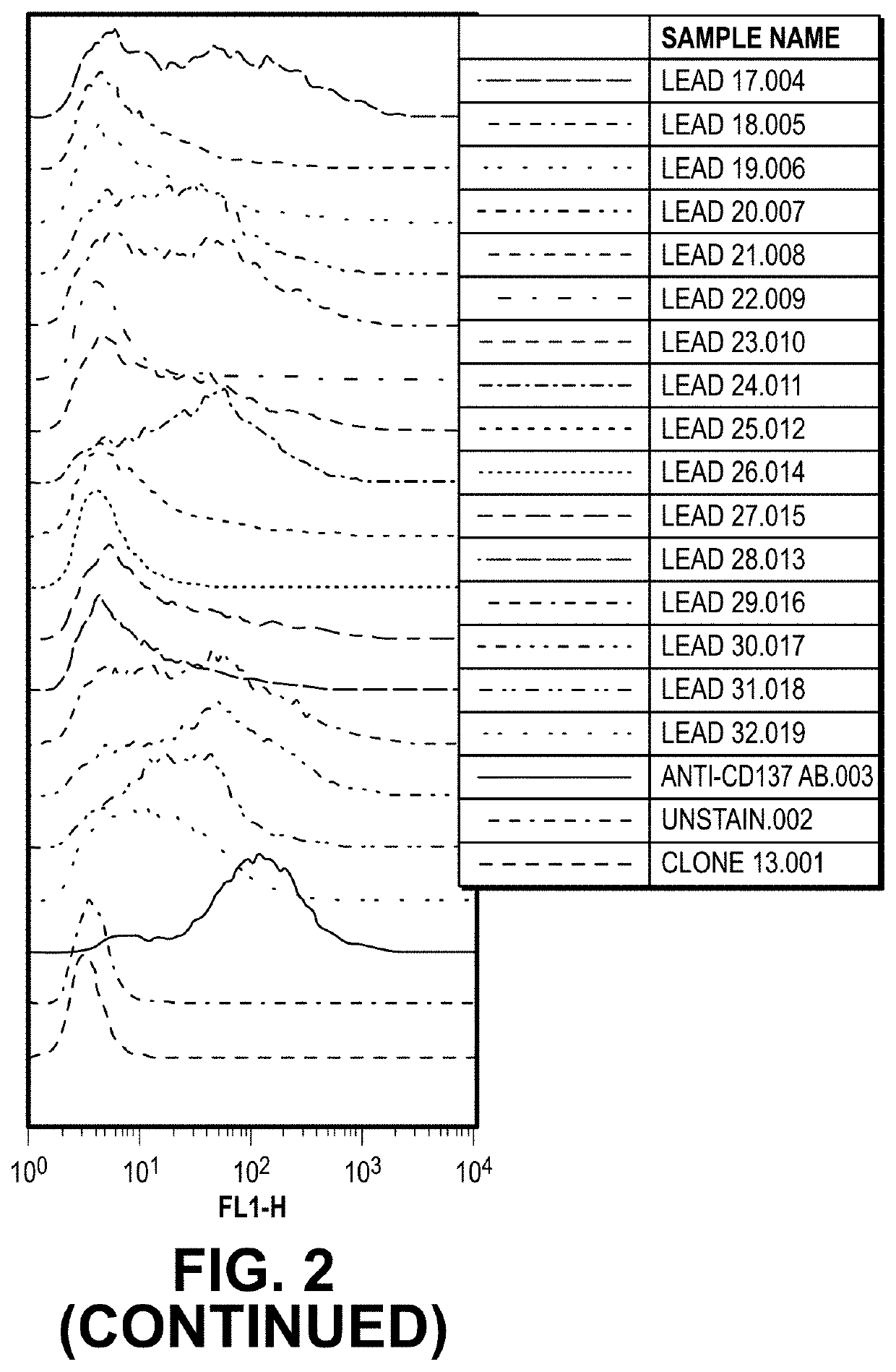Antibodies for t-cell activation
a t-cell and antigen technology, applied in the field of antibodies and antigen binding fragments, can solve the problems of ligand engagement not being determined, unable to determine the potency and toxicity of ligands, and the most trials are not completed, so as to boost the function of t-cell effectors, and enhance the activity of t-cell effectors.
- Summary
- Abstract
- Description
- Claims
- Application Information
AI Technical Summary
Benefits of technology
Problems solved by technology
Method used
Image
Examples
example 1
[0100]This example illustrates antibody generation from an OmniMab library.
[0101]To generate therapeutic antibodies against CD137, selections with an OmniMab phagemid library were carried out. The phagemid library was built up by AP Biosciences Inc. (APBio Inc.) from a collection of peripheral blood mononuclear cells from over a hundred healthy donors. Pre-coated CD137-Fc recombinant protein was incubated with supernatant containing rescued phages for 1 hour and washed three with PBS containing 0.1% Tween-20. Bound phages were detected by HRP conjugated anti-M13 antibody (Roche) and TMB substrate was used for signal development. The OD450 readings were recorded.
[0102]First round panning was performed using Hyperphage (M13K07ΔρIII, Progen, Heidelberg, Germany). Solid phase panning and cell panning against CD137 were used for CD137-specific binder selection and isolation from the OmniMab library. Solid phase panning was performed using recombinant human CD137-ECD-Fc (APBio Inc.) used ...
example 2
[0104]This example illustrates subcloning, expression, and purification of CD137-specific binding proteins in the form of IgGs.
[0105]To quickly screen for candidates with functionality in T cell activation, the heavy chains and light chains of positive CD137 or PD-L1 binders identified by ELISA were amplified, digested and subcloned into an IgG expression vector generated by APBio and carrying the IgG4 constant region (SEQ ID NO. 25). After sequence validation, plasmids were prepared and transfected into HEK293 cells for antibody expression using 293fectin transfection reagent (Invitrogen). After 4 days of culture, antibody secreted into serum-free medium was affinity purified from culture supernatant by Protein G chromatography. Purified antibody was concentrated, followed by dialysis in PBS buffer. The final concentration of dialyzed protein was determined using a NanoDrop2000 spectrophotometer and the purity and integrity were determined by SDS-PAGE with or without reducing reage...
example 3
[0108]This example illustrates binding of anti-CD137 antibody to Jurkat cells.
[0109]Purified anti-CD137 antibody leads were also applied to CD137-induced Jurkat cells to determine binding activity by FACS. Jurkat cells were treated with PMA (10 ng / ml) and ionomycin (1 μg / ml) to induce CD137 expression for 2 days. Stimulated cells were incubated with anti-CD137 (0.5 μg / ml) and reference (ref) Ab (0.5 μg / ml) as positive control for 1 hr on ice, left unstained or incubated with OX40 reference (ref) Ab as negative controls. The cells were washed three times with 1×PBS and then incubated with Alexa-488-conjugated goat anti-human IgG (H+L) (Invitrogen Inc.) on ice for an additional 1 hr. After staining, the cells were washed three times with 1×PBS, resuspended in 1×PBS before being analyzed by FACS Calibur (BD Biosciences, Inc.) and FlowJo (TreeStar, LLC). Among CD137 antibody leads, several leads possessed binding activity comparable to the reference antibody, as shown in FIG. 4.
[0110]Th...
PUM
| Property | Measurement | Unit |
|---|---|---|
| molecular weight | aaaaa | aaaaa |
| molecular weight | aaaaa | aaaaa |
| molecular weight | aaaaa | aaaaa |
Abstract
Description
Claims
Application Information
 Login to View More
Login to View More - R&D
- Intellectual Property
- Life Sciences
- Materials
- Tech Scout
- Unparalleled Data Quality
- Higher Quality Content
- 60% Fewer Hallucinations
Browse by: Latest US Patents, China's latest patents, Technical Efficacy Thesaurus, Application Domain, Technology Topic, Popular Technical Reports.
© 2025 PatSnap. All rights reserved.Legal|Privacy policy|Modern Slavery Act Transparency Statement|Sitemap|About US| Contact US: help@patsnap.com



